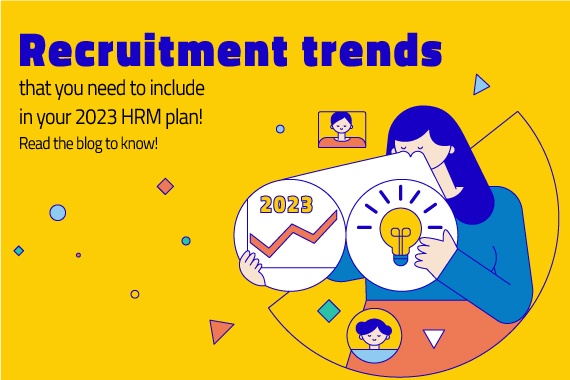
Campus Hiring and the New Talent Pool: Debunking 7 Strange Myths About Recruitment and Selection in HRM
A recent report by Economic Times declared that Indian markets have seen a 42% increase in the hiring of entry-level freshers. If the data stands true for the coming years, the graph would show a remarkable change in the recruitment and selection in HRM processes. But, does it make you wonder why these statistics go high every year, especially in post-pandemic workspaces?
Well, it goes without saying that after the Great Resignation, COVID-19 has been the biggest game-changer in the area of recruitment and selection strategy. When the first massive recession came, the new talent was laid off seeking ways to boost the market. But, today’s market is a dynamic ecology. It grows and sustains itself and needs rapid modernization in terms of campus selection, recruitment, and selection in Human Resource Management.
This leaves a lot of new employees with the question of how these steps in the recruitment and selection process in HRM function. Do they really work, the way we know them? Or, is it about the same old principles that they learn in their market and finance classrooms?
The answer to each of these questions is a yes and a no both at the same time. Markets are very conventional in terms of talent management and retention but when it comes to the recruitment and selection hiring process, it has changed with every single shift in the paradigm.
Here, we are going to discuss 7 such myths that break away from the age-old idea of talent recruitment and hiring in HRM.
Breaking 7 Myths About Recruitment and Hiring in HRM
1. The HR Strategy Is Trivial
The recruitment and selection strategy is essentially the love child of a great HR strategy and marketing prospects. Hence, you need to pay equal attention to each of them. Thinking that your “humanware” is not important in this process is the biggest threat to your futuristic recruitment and hiring strategy.
2. Only Long Term Goals Matter
While hiring new talent from the new campus, you have to think of the immediate need too. We understand that the market has fed all of the ideas of the long-term plan. But, having an employee with no immediate need is also the anchor holding you down. Your modern recruitment and selection hiring process needs to pay attention to the short-term goals too. Think about the immediate future, not the future that depends on a lot of statistics.
3. External Recruit Is Not Important
External recruits like referrals, suggestions, or hiring from a sub-branch is also a great way of expansion. Make the best use of it. Campus hiring is well and good but if a young talent is right there in front of your eyes, the right recruitment process in HRM would suggest you go for it right then.
Thinking that your “humanware” is not important in this process is the biggest threat to your futuristic recruitment and hiring strategy.
4. There Is No Need for A Structure
Recruit and Selection processes take a great deal of time formulating their blueprints. Remember that all great hires are well-thought plans with great structure and back-end support. Ensure that structure first and then cash on the benefits.
5. Cultural Fits Are Significant
Let’s just agree that cultural fit is an age-old concept. We live in a diverse world and thinking that a particular candidate can’t fit in based on unconscious bias is a mere excuse. Try understanding the benefits of a multicultural workspace and hiring a diverse set of talent.
6. Hiring Teams Have A Very Little Say
Hiring teams are important for they are the ones employing all your steps in the recruitment and selection process in HRM. Since the team has hands-on experience with the talent in question, they are also your primary source of suggestions and are very very important.
7. Application Processes Is Not A Serious Procedure

Sorting through applications isn’t an easy feat. While we do have the benefits of technology. But, trusting the bots and the AI is a disaster in making. Take some time out and check out all the employees, and their CVs, and then pick out the best ones to proceed further.
Since the team has hands-on experience with the talent in question, they are also your primary source of suggestions and are very very important.
Conclusion
In addition to meeting job criteria, a good recruitment and selection process in HRM guarantees that your organization will uphold its commitment to giving employees equal opportunity. You may hire the greatest applicants for your company if you abide by these formulas. So, next hiring season, take cues from some of these ideas and hire the best of the best.
Frequently Asked Questions(FAQs)
Q: What are some myths about recruitment and selection strategy?
A: Some of the myths around recruitment and selection strategy include:
- HR strategy is not needed for recruitment
- Neglecting short-term goals is fine
- External referrals aren’t important
- A structured framework for hiring is not important
- Hiring teams are just for interviews
Q: Do we really need recruitment and selection in human resource management?
A: An organization’s dedication to offering equal opportunity to staff is maintained by having an effective recruitment and selection policy. It further guarantees that the job’s requirements are fulfilled. You can fill your organization’s hiring needs with the best individuals if you come up with a customized recruitment and selection strategy.
Q: What are some recruitment and selection processes in HRM?
A: Some recruitment and selection processes in HRM are:
- Before you advertise a position, make a list of your needs
- Write your job description articulately
- Create a recruitment strategy
- Shortlist outstanding candidates
- Perform a phone screening, a personal interview
- Provide an offer of employment








